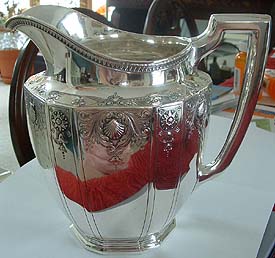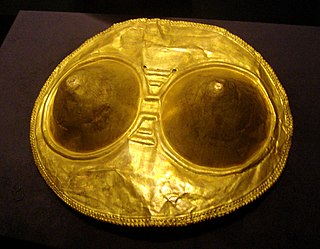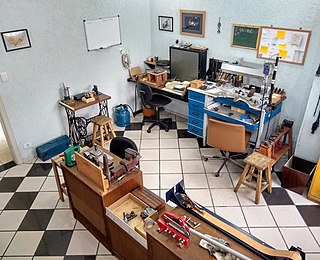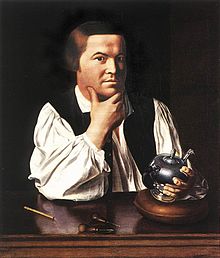
A forge is a type of hearth used for heating metals, or the workplace (smithy) where such a hearth is located. The forge is used by the smith to heat a piece of metal to a temperature at which it becomes easier to shape by forging, or to the point at which work hardening no longer occurs. The metal is transported to and from the forge using tongs, which are also used to hold the workpiece on the smithy's anvil while the smith works it with a hammer. Sometimes, such as when hardening steel or cooling the work so that it may be handled with bare hands, the workpiece is transported to the slack tub, which rapidly cools the workpiece in a large body of water. However, depending on the metal type, it may require an oil quench or a salt brine instead; many metals require more than plain water hardening. The slack tub also provides water to control the fire in the forge.

A blacksmith is a metalsmith who creates objects primarily from wrought iron or steel, but sometimes from other metals, by forging the metal, using tools to hammer, bend, and cut. Blacksmiths produce objects such as gates, grilles, railings, light fixtures, furniture, sculpture, tools, agricultural implements, decorative and religious items, cooking utensils, and weapons. There was an historical distinction between the heavy work of the blacksmith and the more delicate operation of a whitesmith, who usually worked in gold, silver, pewter, or the finishing steps of fine steel. The place where a blacksmith works is called variously a smithy, a forge or a blacksmith's shop.

Sterling silver is an alloy composed by weight of 92.5% silver and 7.5% other metals, usually copper. The sterling silver standard has a minimum millesimal fineness of 925.

A goldsmith is a metalworker who specializes in working with gold and other precious metals. Nowadays they mainly specialize in jewelry-making but historically, goldsmiths have also made silverware, platters, goblets, decorative and serviceable utensils, and ceremonial or religious items.

Repoussé or repoussage ( ) is a metalworking technique in which a malleable metal is shaped by hammering from the reverse side to create a design in low relief. Chasing or embossing is a similar technique in which the piece is hammered on the front side, sinking the metal. The two techniques are often used in conjunction.

Cloisonné is an ancient technique for decorating metalwork objects with colored material held in place or separated by metal strips or wire, normally of gold. In recent centuries, vitreous enamel has been used, but inlays of cut gemstones, glass and other materials were also used during older periods; indeed cloisonné enamel very probably began as an easier imitation of cloisonné work using gems. The resulting objects can also be called cloisonné. The decoration is formed by first adding compartments to the metal object by soldering or affixing silver or gold as wires or thin strips placed on their edges. These remain visible in the finished piece, separating the different compartments of the enamel or inlays, which are often of several colors. Cloisonné enamel objects are worked on with enamel powder made into a paste, which then needs to be fired in a kiln. If gemstones or colored glass are used, the pieces need to be cut or ground into the shape of each cloison.

Tumbaga is the name for a non-specific alloy of gold and copper given by Spanish Conquistadors to metals composed of these elements found in widespread use in pre-Columbian Mesoamerica in North America and South America.

A metalsmith or simply smith is a craftsperson fashioning useful items out of various metals. Smithing is one of the oldest metalworking occupations. Shaping metal with a hammer (forging) is the archetypical component of smithing. Often the hammering is done while the metal is hot, having been heated in a forge. Smithing can also involve the other aspects of metalworking, such as refining metals from their ores, casting it into shapes (founding), and filing to shape and size.

Tinning is the process of thinly coating sheets of wrought iron or steel with tin, and the resulting product is known as tinplate. The term is also widely used for the different process of coating a metal with solder before soldering.
Pickling is a metal surface treatment used to remove impurities, such as stains, inorganic contaminants, and rust or scale from ferrous metals, copper, precious metals and aluminum alloys. A solution called pickle liquor, which usually contains acid, is used to remove the surface impurities. It is commonly used to descale or clean steel in various steelmaking processes.
This article is a list of terms commonly used in the practice of metalworking – the science, art, industry, and craft of shaping metal.

The English wheel, in Britain also known as a wheeling machine, is a metalworking tool that enables a craftsperson to form compound curves from flat sheets of metal such as aluminium or steel.

Firestain is a layer of oxides that is visible on the surface of objects made of metal alloys containing copper when the object is heated, as by a jeweler heating a ring to apply solder during a repair. On copper-containing alloys of gold or of silver, it presents as a red or purple stain. This is because at high temperatures, oxygen mixes with the copper to form cuprous oxide and then cupric oxide, both of which disrupt the bright polished surface of the finished piece. There are various methods used to either prevent or repair firestain.
Foldforming is a technique of metalworking whereby metal is folded, repeatedly forged and annealed, and unfolded; at which stage it generally has a dramatic new three-dimensional form. While alternate spellings abound (e.g., fold-forming, fold forming, Foldforming, and even form-folding, the definitive book "Foldforming" by Charles Lewton-Brain consistently uses the spelling of foldforming as one lowercase word.

Jewelry wire is wire, usually copper, brass, nickel, aluminium, silver, or gold, used in jewelry making.

A bench jeweler is an artisan who uses a combination of skills to make and repair jewelry. Some of the more common skills that a bench jeweler might employ include antique restoration, silversmithing, goldsmithing, stone setting, engraving, fabrication, wax carving, lost-wax casting, electroplating, forging, & polishing.

Fred Fenster is a metalsmith and professor emeritus of the University of Wisconsin at Madison where he taught art and education. He is particularly known for his work in pewter, influencing generations of metalsmiths. Fenster was named a Fellow of the American Craft Council in 1995.

Native American jewelry refers to items of personal adornment, whether for personal use, sale or as art; examples of which include necklaces, earrings, bracelets, rings and pins, as well as ketohs, wampum, and labrets, made by one of the Indigenous peoples of the United States. Native American jewelry normally reflects the cultural diversity and history of its makers, but tribal groups have often borrowed and copied designs and methods from other, neighboring tribes or nations with which they had trade, and this practice continues today. Native American tribes continue to develop distinct aesthetics rooted in their personal artistic visions and cultural traditions. Artists may create jewelry for adornment, ceremonies, and display, or for sale or trade. Lois Sherr Dubin writes, "[i]n the absence of written languages, adornment became an important element of Indian communication, conveying many levels of information." Later, jewelry and personal adornment "...signaled resistance to assimilation. It remains a major statement of tribal and individual identity."

Yemenite silversmithing refers to the work of Jewish silversmiths from Yemen. They were highly acclaimed craftsmen who dominated craft production in precious metals in the southern Arabian peninsula from at least the 18th through the mid-20th century, a period and region during which Muslims did not engage in this work. These Yemenite silversmiths were noted for their skilled use of fine granulation and filigree, producing ornaments such as women's bracelets, necklaces, finials, as well as elaborate scabbard sheaths for men's daggers.
Zahroun Mulla Khidr bin Badran bin Qarjar Al-Zahroun Amara, known simply as Zahroun Amara, was an Iraqi niello silversmith and jeweler who was born in Amarah, Iraq in the late 19th century. Zahroun Amara was a member of the Mandaean community who were famed for their silverwork.



















